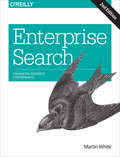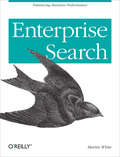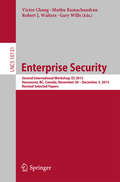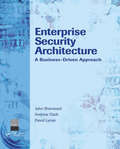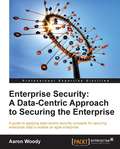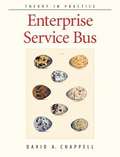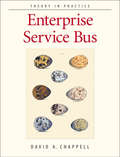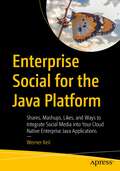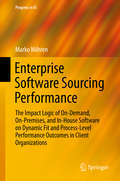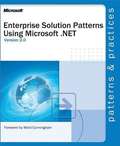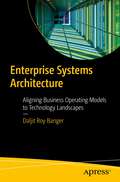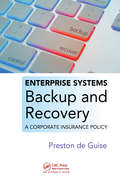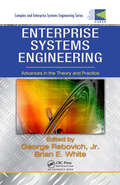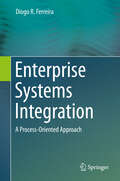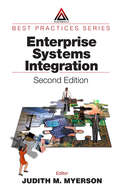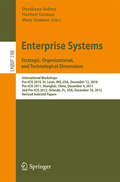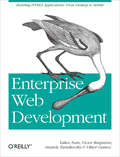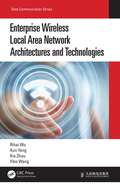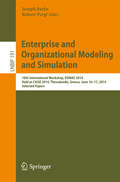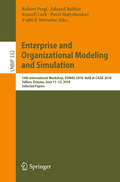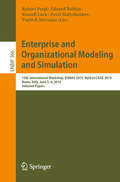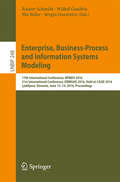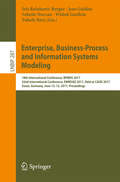- Table View
- List View
Enterprise Search
by Martin WhiteIs your organization rapidly accumulating more information than you know how to manage? This book helps you create an enterprise search solution based on more than just technology. Author Martin White shows you how to plan and implement a managed search environment that meets the needs of your business and your employees. Learn why it's vital to have a dedicated staff manage your search technology and support your users. In one survey, 93% of executives said their organization is losing revenue because they're not fully able to use the information they collect. With this book, business managers, IT managers, and information professionals can maximize the value of corporate information and data assets. Use 12 critical factors to gauge your organization's search needs Learn how to make a business case for search Research your user requirements and evaluate your current search solution Create a support team with technical skills and organizational knowledge to manage your solution Set quality guidelines for organizational content and metadata Get an overview of open source and commercial search technology Choose an application based on your requirements, not for its features Make mobile and location-independent search part of your solution
Enterprise Search: Enhancing Business Performance
by Martin WhiteIs your organization rapidly accumulating more information than you know how to manage? This updated edition of Enterprise Search helps you create an enterprise search solution based on more than just technology. Author Martin White shows you how to plan and implement a managed search environment that meets the needs of your business and your employees. You'll learn why it’s absolutely vital to have a dedicated staff manage your search technology and support your users.New material for this second edition includes material on SharePoint 2013 search, managing open source search development, website search, designing the search user, and assessing search performance. Chapters now include a Further Reading section for computer science and information science students.Topics include:10 critical success factors to assess organizational search maturityEssential skills needed to support a successful search applicationHow to specify and manage open source search developmentHow to manage SharePoint 2013 searchMethods to assess the business impact of searchBest practices in user interface designThe importance of search for websitesWhat to include in a search strategy
Enterprise Search: Enhancing Business Performance
by Martin WhiteIs your organization rapidly accumulating more information than you know how to manage? This book helps you create an enterprise search solution based on more than just technology. Author Martin White shows you how to plan and implement a managed search environment that meets the needs of your business and your employees. Learn why it’s vital to have a dedicated staff manage your search technology and support your users.In one survey, 93% of executives said their organization is losing revenue because they’re not fully able to use the information they collect. With this book, business managers, IT managers, and information professionals can maximize the value of corporate information and data assets.Use 12 critical factors to gauge your organization’s search needsLearn how to make a business case for searchResearch your user requirements and evaluate your current search solutionCreate a support team with technical skills and organizational knowledge to manage your solutionSet quality guidelines for organizational content and metadataGet an overview of open source and commercial search technologyChoose an application based on your requirements, not for its featuresMake mobile and location-independent search part of your solution
Enterprise Security
by Gary Wills Muthu Ramachandran Victor Chang Robert J. WaltersEnterprise security is an important area since all types of organizations require secure and robust environments, platforms and services to work with people, data and computing applications. The book provides selected papers of the Second International Workshop on Enterprise Security held in Vancouver, Canada, November 30-December 3, 2016 in conjunction with CloudCom 2015. The 11 papers were selected from 24 submissions and provide a comprehensive research into various areas of enterprise security such as protection of data, privacy and rights, data ownership, trust, unauthorized access and big data ownership, studies and analysis to reduce risks imposed by data leakage, hacking and challenges of Cloud forensics.
Enterprise Security Architecture: A Business-Driven Approach
by Nicholas SherwoodSecurity is too important to be left in the hands of just one department or employee-it's a concern of an entire enterprise. Enterprise Security Architecture shows that having a comprehensive plan requires more than the purchase of security software-it requires a framework for developing and maintaining a system that is proactive. The book is based
Enterprise Security: A Data-Centric Approach to Securing the Enterprise
by Aaron WoodyIt's a reference guide to enterprise security programs. This book is intended for the IT security staff beginner to expert but would also be a valuable resource for other IT functions such as IT compliance, IT operations, and executives responsible for managing IT and information security. Understanding the principles in this book is important for decision makers as new business models are developed and enterprise security must keep up to reduce risk and secure critical enterprise assets and data.
Enterprise Service Bus
by Dave ChappellEnterprise Service Bus provides an architectural overview of the ESB, showing how it can bring the task of integration of enterprise applications and services built on J2EE, .NET, C/C++, and other legacy environments into the reach of the everyday IT professional, using an event-driven Service-Oriented Architecture. Through the study of real-world use cases drawn from several industries using ESB, the book clearly and coherently outlines the benefits of moving toward this integration strategy.
Enterprise Service Bus: Theory in Practice
by David A ChappellLarge IT organizations increasingly face the challenge of integrating various web services, applications, and other technologies into a single network. The solution to finding a meaningful large-scale architecture that is capable of spanning a global enterprise appears to have been met in ESB, or Enterprise Service Bus. Rather than conform to the hub-and-spoke architecture of traditional enterprise application integration products, ESB provides a highly distributed approach to integration, with unique capabilities that allow individual departments or business units to build out their integration projects in incremental, digestible chunks, maintaining their own local control and autonomy, while still being able to connect together each integration project into a larger, more global integration fabric, or grid.Enterprise Service Bus offers a thorough introduction and overview for systems architects, system integrators, technical project leads, and CTO/CIO level managers who need to understand, assess, and evaluate this new approach. Written by Dave Chappell, one of the best known and authoritative voices in the field of enterprise middleware and standards-based integration, the book drills down into the technical details of the major components of ESB, showing how it can utilize an event-driven SOA to bring a variety of enterprise applications and services built on J2EE, .NET, C/C++, and other legacy environments into the reach of the everyday IT professional.With Enterprise Service Bus, readers become well versed in the problems faced by IT organizations today, gaining an understanding of how current technology deficiencies impact business issues. Through the study of real-world use cases and integration patterns drawn from several industries using ESB--including Telcos, financial services, retail, B2B exchanges, energy, manufacturing, and more--the book clearly and coherently outlines the benefits of moving toward this integration strategy. The book also compares ESB to other integration architectures, contrasting their inherent strengths and limitations.If you are charged with understanding, assessing, or implementing an integration architecture, Enterprise Service Bus will provide the straightforward information you need to draw your conclusions about this important disruptive technology.
Enterprise Social for the Java Platform: Shares, Mashups, Likes, and Ways to Integrate Social Media into Your Cloud Native Enterprise Java Applications
by Werner KeilLearn everything you need to know about frameworks that help developers to integrate their solutions with social networks or APIs, from general purpose (Facebook, Twitter, Google, Mastodon) to specialized (LinkedIn, Xing, WhatsApp, YouTube, Instagram, Flickr, TikTok) to vertical (eToro, Fitbit, Strava). This book will teach you how to add social media features to web applications or services developed using Java, Jakarta EE, or generally running on a Java Virtual Machine (JVM). Jam-packed with practical examples of social integration into enterprise applications, you’ll learn how to address common requirements such as social login, identity federation, single sign-on via social accounts, OpenID Connect, and mashups. You’ll also see how to leverage Java social frameworks like Facebook Business SDK, Twitter4J, Agorava, Keycloak, and Spring Security. Enterprise Social for the Java Platform is an excellent companion to books covering Jakarta EE Security, Spring Security, portals, and related frameworks. Upon completing it, you’ll be armed with the expertise you need to integrate your own Java enterprise applications with social media networks. What You Will Learn Harness the reach and power of social media platforms by integrating your enterprise Java applications with themUnderstand social media standards for different platformsAddress common security issues Who This Book Is For Developers, architects, and managers of projects involving the use of APIs or Social Networks.
Enterprise Software Sourcing Performance
by Marko NöhrenThis book opens the "black box" of software sourcing by explaining how dynamic software alignment is established and how it impacts business performance outcomes. By investigating how software-sourcing modes are related to value generation in the post-implementation phase, it shows researchers and managers the impact logic of on-demand, on-premises, and in-house software on dynamic fit and process-level performance outcomes in a client organization. It describes dynamic IT alignment as the key to success in a fast-moving digital world with software-as-a-service on the rise and highlights the fact that today companies can choose between developing software in-house (make) or sourcing packaged systems in an on-premises (buy) or an on-demand (lease) mode. This book is the first to explicitly compare these sourcing arrangements with each other in terms of alignment and business performance.
Enterprise Solution Patterns Using Microsoft® .NET
by Microsoft CorporationGet expert guidance on patterns--simple, proven mechanisms by which software professionals can share important architectural tradeoffs and design decisions--and help reduce the complexity of building high-performance, enterprise-class business solutions. Focusing on architectural, design, and implementation patterns for Microsoft .NET, this guide captures the knowledge of seasoned developers and shares their time-tested patterns and best practices. Developers and architects learn how to use individual patterns for specific technical scenarios, as well as how to combine patterns to build more complex solutions. All PATTERNS & PRACTICES guides are reviewed and approved by Microsoft engineering teams, consultants, partners, and customers--delivering accurate, real-world information that's been technically validated and tested.
Enterprise System Architectures: Building Client Server and Web Based Systems
by Michael C. Davis Mark Goodyear Hugh W. Ryan Scott R. Sargent Stanton J. Taylor Timothy M. Boudreau Yannis S. Arvanitis Richard A. Chang John K. Kaltenmark Nancy K. Mullen Shari L. Dove John C. Clark Craig MindrumExperts from Andersen Consulting show you how to combine computing, communications, and knowledge to deliver a uniquely new-and entirely indispensable-competitive advantage.Lead, Follow, or get out of the wayYour company's ability to sustain a competitive advantage is in jeopardy. Your competitors can imitate and improve faster than ever. You need to find ways to help your company discover and deliver and astounding solution, control its costs, and move on the next astounding solution.Web-based computing is the vital technology enabler for today's most important business opportunities, like E-Commerce. It is also the flexible foundation for future solutions. However, because of the complexities and difficulties it represents, it can be critical hurdle for IT shops and for an entire business. Enterprise Systems Architecture: Building Client/Server and Web-Based Systems is your guide through these complexities as you integrate your technology capabilities with your strategy, people, and processes to deliver astounding solutions. It Introduces you to basic principles and concepts, provides an overview of state-of-the-art in client/server and Web-based computing models, and develops a solid business case for implementation.Acquaints you with various technologies involved and describes a comprehensive network computing architecture.Details crucial analysis, design, and implementation issues, including design specifics for architectures, applications, and network; rollout strategies; and ongoing management of distributed operations. Explores emerging technologies and their likely impact on the future of netcentric computing.Here you'll find detailed information on the architectures and frameworks for network-based computing � strategies for designing and implementing solutions � strategies and methods for security. It also provides a full framework for testing applications, and in-depth dis
Enterprise Systems Architecture: Aligning Business Operating Models to Technology Landscapes
by Daljit Roy BangerEnhance your technical and business skills to better manage your organization’s technology ecosystem. This book aims to explain how to align the technology landscape to service your company’s business operating model. The book begins by exploring different architectural approaches before taking a deep dive into multiple layers of the architectural stack and the methodology of each component. You’ll also learn about the many products delivered by enterprise architecture. To complete the book, author Daljit Banger delves into the various roles and responsibilities of an enterprise architect. After completing Enterprise Systems Architecture, you will understand how to develop an ICT (Information Communication Technology) strategy to meet the needs of your organization. What Will You Learn Gain a complete understanding of enterprise architectureConceptualize the enterprise ecosystem using the EsA canvasMaster the products and services of an enterprise architecture function Who This Book Is For Architects (Enterprise, Solution, or Technical), CTOs, Business Analysts, or any stakeholder in delivering technology services to their organization.
Enterprise Systems Backup and Recovery: A Corporate Insurance Policy
by Preston de GuiseThe success of information backup systems does not rest on IT administrators alone. Rather, a well-designed backup system comes about only when several key factors coalesce-business involvement, IT acceptance, best practice designs, enterprise software, and reliable hardware. Enterprise Systems Backup and Recovery: A Corporate Insurance Policy prov
Enterprise Systems Engineering: Advances in the Theory and Practice (Complex and Enterprise Systems Engineering)
by Brian E. White George RebovichAlthough usually well-funded, systems development projects are often late to market and over budget. Worse still, many are obsolete before they can be deployed or the program is cancelled before delivery. Clearly, it is time for a new approach. With coverage ranging from the complex characteristics and behaviors of enterprises to the challenges the
Enterprise Systems Integration
by Diogo R. FerreiraThe field of enterprise systems integration is constantly evolving, as every new technology that is introduced appears to make all previous ones obsolete. Despite this continuous evolution, there is a set of underlying concepts and technologies that have been gaining an increasing importance in this field. Examples are asynchronous messaging through message queues, data and application adapters based on XML and Web services, the principles associated with the service-oriented architecture (SOA), service composition, orchestrations, and advanced mechanisms such as correlations and long-running transactions. Today, these concepts have reached a significant level of maturity and they represent the foundation over which most integration platforms have been built. This book addresses integration with a view towards supporting business processes. From messaging systems to data and application adapters, and then to services, orchestrations, and choreographies, the focus is placed on the connection between systems and business processes, and particularly on how it is possible to develop an integrated application infrastructure in order to implement the desired business processes. For this purpose, the text follows a layered, bottom-up approach, with application-oriented integration at the lowest level, followed by service-oriented integration and finally completed by process-oriented integration at the topmost level. The presentation of concepts is accompanied by a set of instructive examples using state-of-the-art technologies such as Java Message Service (JMS), Microsoft Message Queuing (MSMQ), Web Services, Microsoft BizTalk Server, and the Business Process Execution Language (BPEL). The book is intended as a textbook for advance undergraduate or beginning graduate students in computer science, especially for those in an information systems curriculum. IT professionals with a background in programming, databases and XML will also benefit from the step-by-step description of the various integration levels and the related implementation examples.
Enterprise Systems Integration
by Judith M. MyersonThe convergence of knowledge, technology, and human performance which comprises today's enterprise allows creative business process design. Thus, an organization can create new and innovative ways to service customers or to do business with suppliers and make itself a leader in its field. This capability relies on a successful strategy that integra
Enterprise Systems. Strategic, Organizational, and Technological Dimensions
by Darshana Sedera Norbert Gronau Mary SumnerThis book contains 15 thoroughly refereed research papers selected from 90 submissions for the 5th, 6th, and 7th International Workshop on Enterprise Systems, Pre-ICIS 2010-2012, held in St. Louis, MO, USA, in December 2010, in Shanghai, China, in December 2011, and in Orlando, FL, USA, in December 2012, respectively. In addition, two invited papers complete this volume. The contributions in this edited book are multidisciplinary in scope and cover strategic, organizational, and technological dimensions. They range from purely conceptual to literature reviews to papers on teaching-related aspects. Taken together, these papers provide a holistic view of the enterprise systems research domain, including key characteristics, implementation issues, general aspects of enterprise systems use, specific solutions such as CRM and SCM, and future research directions.
Enterprise Web Development: Building HTML5 Applications: From Desktop to Mobile
by Yakov Fain Victor Rasputnis Anatole Tartakovsky Viktor GamovIf you want to build your organization’s next web application with HTML5, this practical book will help you sort through the various frameworks, libraries, and development options that populate this stack. You’ll learn several of these approaches hands-on by writing multiple versions of a sample web app throughout the book, so you can determine the right strategy for your enterprise.What’s the best way to reach both mobile and desktop users? How about modularization, security, and test-driven development? With lots of working code samples, this book will help web application developers and software architects navigate the growing number of HTML5 and JavaScript choices available. The book’s sample apps are available at http://savesickchild.org.Mock up the book’s working app with HTML, JavaScript, and CSSRebuild the sample app, first with jQuery and then Ext JSWork with different build tools, code generators, and package managersBuild a modularized version of the app with RequireJSApply test-driven development with the Jasmine frameworkUse WebSocket to build an online auction for the appAdapt the app for both PCs and mobile with responsive web designCreate mobile versions with jQuery Mobile, Sencha Touch, and PhoneGap
Enterprise Wireless Local Area Network Architectures and Technologies (Data Communication Series)
by Rihai Wu Xun Yang Xia Zhou Yibo WangThis book has been written with the support of Huawei's large accumulation of technical knowledge and experience in the WLAN field, as well as its understanding of customer service requirements. First, the book covers service challenges facing enterprise wireless networks, along with detailing the latest evolution of Wi-Fi standards, air interface performance, and methods for improving user experience in enterprise scenarios. Furthermore, it illustrates typical networking, planning, and scenario-specific design for enterprise WLANs, and provides readers with a comprehensive understanding of enterprise WLAN planning, design, and technical implementation, as well as suggestions for deployment. This is a practical and easy-to-understand guide to WLAN design, and is written for WLAN technical support and planning engineers, network administrators, and enthusiasts of network technology. Authors Rihai Wu is Chief Architect of Huawei's campus network WLAN solution with 16 years of experience in wireless communications product design and a wealth of expertise in network design and product development. He previously served as a designer and developer of products for Wideband Code Division Multiple Access (WCDMA), LTE indoor small cells, and WLAN. Xun Yang is a WLAN standard expert from Huawei. He has nine years of experience in formulating WLAN standards, and previously served as 802.11ac Secretary, 802.11ah PHY Ad-hoc Co-chair, and 802.11ax MU Ad Hoc Sub Group Co-chair. Mr. Yang oversees technical research, the promotion of standards, and industrialization in the WLAN field, and has filed more than 100 patents. Xia Zhou is a documentation engineer of Huawei's campus network WLAN solution. She has 10 years of experience in creating documents for campus network products. Ms. Zhou was previously in charge of writing manuals for Huawei data center switches, WLAN products, and campus network solutions. She is also the author of Campus Network Solution Deployment Guide and was a co-sponsor of technical sessions such as WLAN from Basics to Proficiency. Yibo Wang is a documentation engineer of Huawei's campus network WLAN solution. He has nine years of experience in creating documents for campus network products. Mr. Wang was previously in charge of writing manuals for Huawei switches, WLAN products, and routers. He was also a co-sponsor of technical sessions such as WLAN from Basics to Proficiency and HCIA-WLAN certification training courses.
Enterprise and Organizational Modeling and Simulation
by Robert Pergl Joseph BarjisThis book constitutes the proceedings of the 10th International Workshop on Enterprise and Organizational Modeling and Simulation, EOMAS 2014, held in conjunction with CAiSE 2014 in Thessaloniki, Greece, in June 2014. Tools and methods for modeling and simulation are widely used in enterprise engineering, organizational studies, and business process management. In monitoring and evaluating business processes and the interactions of actors in a realistic environment, modeling and simulation have proven to be both powerful, efficient, and economic, especially if complemented by animation and gaming elements. The 12 contributions in this volume were carefully reviewed and selected from 22 submissions. They explore the above topics, address the underlying challenges, find and improve solutions, and show the application of modeling and simulation in the domains of enterprises, their organizations and underlying business processes.
Enterprise and Organizational Modeling and Simulation: 13th International Workshop, Eomas 2017, Held At Caise 2017, Essen, Germany, June 12-13, 2017, Selected Papers (Lecture Notes in Business Information Processing #298)
by Eduard Babkin Robert Pergl Russell Lock Pavel Malyzhenkov Vojtěch MerunkaThis book constitutes the refereed proceedings of the 14th International Workshop on Enterprise and Organizational Modeling and Simulation, EOMAS 2018, held in Tallinn, Estonia, in June 2018. The main focus of EOMAS is on the role, importance, and application of modeling and simulation within the extended organizational and enterprise context. The 11 full papers presented in this volume were carefully reviewed and selected from 22 submissions. They were organized in topical sections on conceptual modeling, enterprise engineering, and formal methods.
Enterprise and Organizational Modeling and Simulation: 15th International Workshop, EOMAS 2019, Held at CAiSE 2019, Rome, Italy, June 3–4, 2019, Selected Papers (Lecture Notes in Business Information Processing #366)
by Eduard Babkin Robert Pergl Russell Lock Pavel Malyzhenkov Vojtěch MerunkaThis book constitutes the refereed proceedings of the 15th International Workshop on Enterprise and Organizational Modeling and Simulation, EOMAS 2019, held in Rome, Italy, in June 2019. The main focus of EOMAS is on the role, importance, and application of modeling and simulation within the extended organizational and enterprise context. The 12 full papers presented in this volume were carefully reviewed and selected from 25 submissions. They were organized in topical sections on conceptual modeling, enterprise engineering, and formal methods.
Enterprise, Business-Process and Information Systems Modeling
by Rainer Schmidt Wided Guédria Ilia Bider Sérgio GuerreiroThis book contains the refereed proceedings of the 17th International Conference on Business Process Modeling, Development and Support, BPMDS 2016, and the 21st International Conference on Exploring Modeling Methods for Systems Analysis and Design, EMMSAD 2016, held together with the 28th International Conference on Advanced Information Systems Engineering (CAiSE 2016) in Ljubljana, Slovenia, in June 2016. The focus theme for BPMDS 2016 papers was "Business Processes in a Connected World", for which three subthemes were identified: business processes for connecting people, connecting intelligent objects to business processes and connecting information/data/knowledge to business processes. The 17 full and 1 short paper accepted for BPMDS were selected from 48 submissions and are grouped into topical sections on process execution support; improving usability of process models; social and human perspectives; new directions in process modeling; consistency, correctness and compliance; process and data mining; and process variability. The intention of EMMSAD is to solicit papers related to the field of information systems analysis and design including numerous information modeling methods and notations that are typically evolving. These ongoing changes significantly impact the way information systems, enterprises, and business processes are being analyzed and designed in practice. The 12 full papers accepted for EMMSAD were chosen from 19 submissions and are grouped into topical sections on fundamental issues in modeling; requirements and regulations; enterprise and software ecosystem modeling; information and process model quality; meta-modeling and domain specific modeling and model composition; and modeling of architecture and design.
Enterprise, Business-Process and Information Systems Modeling: 18th International Conference, BPMDS 2017, 22nd International Conference, EMMSAD 2017, Held at CAiSE 2017, Essen, Germany, June 12-13, 2017, Proceedings (Lecture Notes in Business Information Processing #287)
by Iris Reinhartz-Berger, Jens Gulden, Selmin Nurcan, Wided Guédria and Palash BeraThis book constitutes the proceedings of two events held in conjunction with the CAiSE conferences and related to the areas of enterprise, business-process and information systems modeling: the 18th International Conference on Business Process Modeling, Development and Support, BPMDS 2017, and the 22nd International Conference on Evaluation and Modeling Methods for Systems Analysis and Development, EMMSAD, 2017. They took place in Essen, Germany, in June 2017. The focus theme for BPMDS 2017 papers was “Enabling Business Transformation by Business Process Modeling, Development and Support". From 24 submitted papers, 11 were finally accepted and organized by: Non-functional considerations in business processes; new challenges in business process modeling and support; testing business processes; business process model comprehension; an experience report on teaching business process modeling. The EMMSAD conference focuses on evaluating, exploring and enhancing modeling methods and techniques for the development of information and software systems, enterprises, and business processes. It received 25 submissions, from which 9 full and 2 short papers were selected and organized: evaluation and comparison of modeling languages and methods; modeling approaches to support decision making; behavioral specification and business process modeling; and modeling languages and methods in evolving context.
